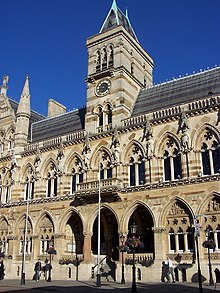Northampton Borough Councilwas theborough councilandnon-metropolitan districtresponsible forlocal governmentin the large town ofNorthamptonin England. In 2021 the council was abolished and succeeded by West Northamptonshire Council; a unitary authority, and the Northampton Town Council, a parish council.
Northampton Borough Council | |
|---|---|
 | |
| Type | |
| Type | |
| Seats | 45 |
| Elections | |
Last election | 7 May 2015 |
| Meeting place | |
 | |
| Website | |
| www.northampton.gov.uk | |
Theleader and cabinetmodel of decision-making had been adopted by the council. It consisted of 45 councillors, representing 33 wards in the town, overseen by a mayor, leader and cabinet. The main council building wasNorthampton Guildhall.
History
editNorthampton was granted its first town charter in 1189 by KingRichard Iand was permitted the appointment of a mayor in 1215 by KingJohn.Northampton first existed as anancient boroughin medieval Britain before being one of the 178 boroughs to be reformed under theMunicipal Corporations Actin 1835. Under theLocal Government Act,it was then recognised as acounty boroughof 6 wards from 1898, 9 wards from 1900 and 12 wards from 1911.[1]Northampton was granted modernborough statusin 1974 under theLocal Government Act 1972as Northampton Borough Council, anon-metropolitan districtcouncil underNorthamptonshire County Council.[2][3]
Northampton was the most populous urban district in England not to be administered as aunitary authority,a status it failed to obtain in the1990s local government reform.[4]During theLocal Government Commission for England (1992),Northampton was rejected from becoming a unitary authority because it was decided that "the separation of Northampton from its county would have a significant and detrimental effect."[5][6][7]The government announced its acceptance of these recommendations in March 1996.[8]In 2000, Northampton applied unsuccessfully forcity status,held to celebrate the newmillennium.
In March 2018, an independent report commissioned by the Secretary of State for Housing, Communities and Local Government, proposed structural changes to local government inNorthamptonshire.These proposals saw the existing county council and district councils abolished and two new unitary authorities created in their place.[9]One authority would consist of the existing districts ofDaventry,NorthamptonandSouth Northamptonshireand the other authority would consist ofCorby,East Northamptonshire,KetteringandWellingboroughdistricts.[10]
Abolition and replacement
editIn 2021 the council was abolished and succeeded byWest NorthamptonshireCouncil; aunitary authority,andNorthampton Town Council,aparish council.This was done, in part, due to failing acorruptionprobe into the disappearance of over £10 million.[11]
Governance
editThe leader and cabinet model of decision-making, adopted by the borough council under theLocal Government Act 2000,is similar tonational government.The council appointed the Leader (usually a member of the group with the political majority) and the Leader appointed up to five other councillors to serve on the cabinet. The cabinet members were responsible for different key areas of local governance including environment; community engagement; housing; planning, regeneration and enterprise; and finance.
The full council met various times during the year. The full council set the annual budget and the council's overall policies. It also had responsibility for amendments to the council's constitution and was responsible for appointing the leader, the executive, and the committees of the council.
Political control
editPolitical control of the non-metropolitan district has been held by the following groups:
| Election | Party | |
|---|---|---|
| 1973 | Labour | |
| 1976 | Conservative | |
| 1979 | Conservative | |
| 1983 | No overall control Conlargest single party | |
| 1987 | Conservative | |
| 1991 | No overall control | |
| 1995 | Labour | |
| 1999 | Labour | |
| 2003 | No overall control Conlargest single party | |
| 2007 | Liberal Democrats | |
| 2011 | Conservative | |
| 2015 | Conservative | |
Arms
edit
|
See also
editReferences
edit- ^"British History".
- ^"District Councils and Boroughs".Parliamentary Debates (Hansard).28 March 1974.Retrieved16 January2012.
- ^"Table III(a)".Local Government in England and wales. a Guide to the New System.London:HMSO.1974. pp. 15–109.ISBN0117508470.
- ^"City winners named".BBC News.18 December 2000.Retrieved2 April2008.
- ^Meikle, James (27 September 1995). "Councils fight on for unitary status: Three authorities miss out on all-purpose target".The Guardian.
- ^Schoon, Nicholas (20 December 1995). "Nine cities 'need greater powers'".The Independent.
- ^LGCE.Final Recommendations on the Future Local Government of: Basildon & Thurrock, Blackburn & Blackpool, Broxtowe, Gedling & Rushcliffe, Dartford & Gravesham, Gillingham & Rochester Upon Medway, Exeter, Gloucester, Halton & Warrington, Huntingdonshire & Peterborough, Northampton, Norwich, Spelthorne and the Wrekin.December 1995.
- ^"Local Government: Structure".Parliamentary Debates (Hansard).House of Lords. 14 March 1996. col. WA71–WA74.
- ^"Troubled council 'should be scrapped'".BBC News.15 March 2018.
- ^"Northamptonshire County Council 'should be split up', finds damning report".
- ^"Northampton Town and the missing millions: A timeline of events".BBC News.24 July 2018.Retrieved20 August2021.
- ^"East Midlands Region".Civic Heraldry of England.Retrieved5 March2021.